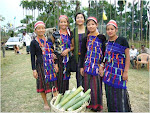
Munin Barkotoki (1915-1993)
Excerpts from the 'Foreword' written by Ranjit Kumar Dev Goswami to A Munin Barkotoki Miscellany (1998, Guwahati: Book Hive).
A distinguished mind of our times, Munin Barkotoki was a man of wide-ranging curiosity and exceptionally varied interests. His passions included literature, journalism, theatre, film, music, painting, sports and - of course - politics. Though his literary output was sparse - comprising almost wholly of just twelve stories and sketches, five poems or pastiches, a one-act play, sundry essays, notes, belles-lettres, reviews, letters to the editor and a book of biographical studies(Bismrita Byatikram) all publishd over a long span of six decades -- Barkotoki exerted a quiet but effective influence on the literary scene in Assam in his role as a conscientious man of letters open to new ideas and experiments. Deeply contemplative, yet warm-hearted and convivial he lived a rich inner life untainted by any mundane quest for glory, power or profit. ....
Munin Barkotoki was born at Jorhat on the Kati Bihu day (October 16-17) of the year 1915, the younger son of Raisaheb Durgadhar Barkotoki, then Divisional Inspector of Schools, and Kamalini Devi, daughter of Padmavati Devi Phukanani (1853-1927) whose Sudharmar Upakhyan (1884) marks an early phase of the development of Assamese prose fiction in the nineteenth century. From his mother's side, his great grandfather was Anandaram Dhekial Phukan (1829-59), pioneer of the nineteenth century Assamese renaissance, and his great great grandfather Haliram Dhekial Phukan (1802-32), an important custom official at Hadira Choky during the Ahom rule who rose in the esteem of the East India Company officials by virtue of his intimate knowledge of revenue administration and socio-political history of Assam. [End of Excerpt]
A few other sundry facts worthy of note:
Munin Barkotoki's elder brother was Satyen Barkotoki, whose Escapades of a Magistrate (1961), is perhaps the first book of its kind in English written by an Assamese.
In 1959, Munin Barkotoki married Renuka Devi Barkataki, who was elected to Parliament in 1962 and again in 1977, when she became the Minister of State for Education, Culture and Social Welfare in the Janata party ministry headed by Sri Morarji Desai.
Read more...





